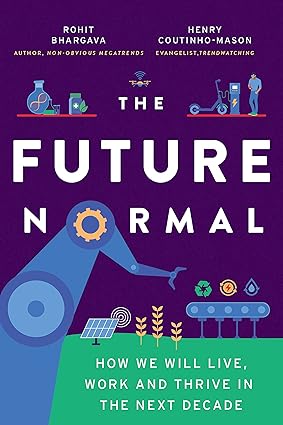
Where we read business books so you don’t have to! ECI recently hosted a workshop discussing the key trends shaping the future of the subsectors that we invest in, using The Future Normal by futurists Henry Coutinho-Mason and Rohit Bhargava to shape our discussion. With Dell Technologies and the Institute For The Future stating that 85% of the jobs that will exist in 2030 haven’t even been invented yet, there is no doubt we are in a period of rapid change. But what did the ECI team think were some of the key drivers transforming the world we invest in?
1. ESG as a cross-sector theme
Certification: The world is looking for more from its companies than profit. Whether it is facing up to the urgent needs of climate change or recognition of corporate responsibility for DEI, companies are looking to make progress and demonstrate that progress. That has led to the growth of certifications like Climate Neutral and B Corp (for example, ECI is now B Corp certified!) which was established to enshrine principles of good practice, and will be something more companies think about over the next decade. Across the HR tech space, there will be more training to support this shift, with things such as carbon comprehension and DEI literacy now a vital part of people’s skills.
Carbon footprint: Climate change awareness will have an impact on consumer and B2B decision-making, with the likes of Quorn already highlighting their footprint vs others and more businesses being asked about their full supply chain. We are already seeing this in the cloud and digital service subsector, with data centres increasingly under pressure to use renewable energy so the whole supply chain can be made more efficient. There is a transition away from seeing tech as the ‘non-impactful’ sector on climate, as people become more aware of the full scope of a company’s footprint. There is also a surge in software platforms trying to accelerate the ease of carbon calculations as it will likely impact every company in the future.
Climate impact: The impact of climate change will also impact supply chain risk, with the geography of customers or suppliers playing into potential disruption. The increased volatility caused by climate change will also have a direct impact on sectors such as insurance, with companies already adjusting how premiums are calculated with climate change impact in mind and which may lead to more volatility in the market.
2. Cyber transformation
“Generate a phishing attack”: In the wake of generative AI, Andrej Karpathy, former head of AI at Tesla, stated that “the hottest new programming language is English.” What this means is that we should be about to witness innovation at a scale and pace not seen before. This is great, however, the downside is that just as coding becomes more accessible to people across your business, it’s also more accessible to bad actors. It is likely that cyber hackers will be able to professionalise their output using these new tools, and the cyber protections in place will need to scale and innovate as well. Another future challenge may be quantum computing. If cracked it opens up the possibility of cracking passwords instantaneously at scale.
Evidence of security: With the already growing number of cyber-attacks likely to further accelerate in coming years, company cyber protection will be paramount, and this will extend beyond their own business to their full supply chain. We are seeing more demand for certifications such as ISO 27001 as evidence that the whole supply chain has strong data security, with our recent investment, ISMS.online, one business that is supporting companies to ensure robust cyber standards.
Remote vulnerabilities: One of the biggest challenges still facing the cyber security sector is how to tackle the vulnerabilities opened by remote working. In the Future Normal, the authors note that we are likely to see an extension of this remote working beyond just white-collar jobs, with examples ranging from remote tattoo artists using robot arms for a publicity stunt for T-Mobile, to genuine experiments of trucks driven remotely at logistics firms. We can all imagine the potential impact on supply chain logistics and costs if that can be done remotely – but security will clearly be integral (whether to ensure the safety of the roads, or the correct spelling of your wife’s name on your upper bicep!)
3. Coming to terms with fake media
Welcome to the deepfake world: Deepfakes are not new, but the quality and sophistication have changed in recent years, as has accessibility. This will have a knock-on effect on multiple sectors, and technology will be needed to solve the issue. For example, sophisticated Digital Asset Management (“DAM”) platforms are helping customers to sure up the integrity of their content through sophisticated verification techniques, and by guarding against 3rd party AI’s misuse of proprietary images and video. This is relevant to any industry that places value on digital media or documentation – we are no longer in a world where seeing is believing. We are seeing particularly strong demand in high-stakes environments, such as law enforcement, publishing, and insurance.
Digital and social media: Trust in the media is incredibly low, in fact, it’s got so bad that half of Americans now believe that national news organisations intend to mislead them. Digital platforms have a job to do which is to verify news, deal with the proliferation of content that will be produced by large language models and may or may not be true, and engender trust within their audiences. We are already seeing some element of this with X’s community notes, and you’d expect that this will continue as the problem escalates (and advertisers no longer want to sit alongside doctored images and propaganda).
The need for safeguarding: We are already seeing horrible deepfake stories emerge of images being used by bad actors, highlighting the urgency of protecting images shared online, as well as ensuring that people cannot access that content through platforms. Business owners and investors have a responsibility to hold tech companies to account, for example through how images are identified with AI and removed automatically, as well as limiting the use of encrypted platforms that can provide a safe haven for sinister actors.
4. Changes in how we learn
Stealth learning: How can we all learn quicker? Innovative new developments include passive haptic learning, where electrical impulses are sent to help teach manual skills, with impressive results claiming to help you learn braille in 30 minutes. If haptic learning is a bit too intense, there are also more opportunities for stealth learning in video games, for example, Roblox has invested in Roboco, a virtual robotics game that engages players in STEM learning as they play. This can already be used by schools to help teach coding. Similarly, companies such as Labster create virtual lab simulations which make science experiments more accessible (and reduce risk). There is evidence that this virtual and immersive experience can create higher engagement, especially if Edtech companies can leverage or replicate the channels that children already use to encourage learning.
Flow of work training: There is evidence that people are trained better through micro-learning rather than long training sessions where individuals quickly switch off, with learning management systems such as Digits, part of ECI portfolio company Ciphr, enabling people to be trained as they go through modules. AI has unlocked even more ability to train in the flow of work, with Microsoft announcing the launch of Co-Pilot which means employees can ask questions as they go alongside their office platform.
Classroom technology: When it comes to primary and secondary education, there are many fantastic solutions already in place. However, one of the most significant problems is accessibility. The proliferation of tech in classrooms is well behind the US, and it risks creating disadvantages for children if technology is being leveraged but with different accessibility across children. Companies that can ensure technology can be provided, and crucially be provided securely, will be important to make sure the potential in how we change learning behaviours becomes a reality.
5. Retention becomes key
Matching skills and shortages: A shrunk labour force that is quite footloose seems to be a trend that is here to stay post-pandemic. With it comes more onus for companies to retain their talent, as recruitment becomes increasingly difficult. Training is key to keeping talent, and as tech and its associated skillsets have evolved more rapidly, it will become essential for companies to be able to access the skills they need. Companies like ECI-alumni, Mthree, upskill people around specific tech skillsets and place them in companies, which increasingly makes more sense than trying to recruit people with the skillsets already in place in a competitive market.
D&I, wellbeing, and job sharing: Successful retention often means being at the forefront of thinking about employee wellbeing and ensuring there is an inclusive culture for them. The Future Normal states that in coming years companies will need to be able to demonstrate meaningful efforts on D&I, rather than small tweaks or ad campaigns. Reflective cultures will become imperative at Board level down, and to support this there is a surge in companies signing up to initiatives that commit to reporting on their own data. Innovative solutions around job sharing may also become more commonplace, for example, two Partners at Baker McKenzie job-share the same job 3 days a week each. This is unique solution in trying to solve for how to retain people with families as they pursue a career, and job-sharing platforms are now in place to tap into this market.


